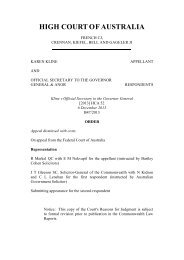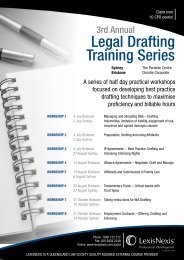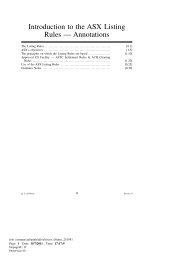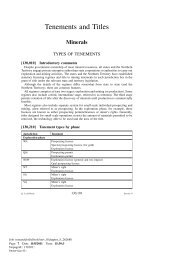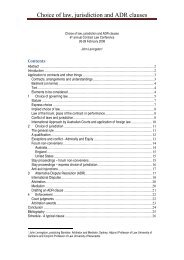Copyright LexisNexis. Sample only, not for classroom use or ...
Copyright LexisNexis. Sample only, not for classroom use or ...
Copyright LexisNexis. Sample only, not for classroom use or ...
You also want an ePaper? Increase the reach of your titles
YUMPU automatically turns print PDFs into web optimized ePapers that Google loves.
PRINCIPLES OF AUSTRALIAN EQUITY AND TRUSTS<br />
modern doctrine of equitable estoppel can provide relief in various other areas where contractual<br />
remedies are unavailable. Some of these areas include:<br />
• where, during negotiations to enter into a contract, an offeree, believing that the offer will <strong>not</strong> be<br />
revoked proceeds to act to his <strong>or</strong> her detriment upon that belief;<br />
• where there has been non-compliance with the statut<strong>or</strong>y requirement of writing with respect to<br />
a contract involving land;<br />
• where the rule in Hoyt’s Pty Ltd v Spencer (1919) 27 CLR 133 precludes the finding of a collateral<br />
contract: Wright v Hamilton Island Enterprises Ltd [2003] QCA 36;<br />
• where the doctrine of privity prevents a third party to the contract from en<strong>f<strong>or</strong></strong>cing it: Trident<br />
General Insurance Co Ltd v McNiece Bros Pty Ltd (1988) 165 CLR 107 at 145; 80 ALR 574 at 601.<br />
12.14 The principles which underlie promiss<strong>or</strong>y estoppel were present in nineteenth century case<br />
law, but they were given a m<strong>or</strong>e contemp<strong>or</strong>ary <strong>f<strong>or</strong></strong>mulation by Denning J in the case of Central<br />
London Property Trust Ltd v High Trees Ho<strong>use</strong> Ltd [1947] 1 KB 130. In that case Central London<br />
Property Trust (CLPT) leased a block of flats to High Trees Ho<strong>use</strong> (HTH) <strong>f<strong>or</strong></strong> a period of 99 years.<br />
In 1940, CLPT agreed to accept a reduced rent, which was paid <strong>f<strong>or</strong></strong> the next five years by HTH. CLPT<br />
accepted the reduction beca<strong>use</strong> of the low occupancy rate <strong>f<strong>or</strong></strong> the flats during W<strong>or</strong>ld War II. In 1945,<br />
with the flats all fully let, CLPT asserted a claim <strong>f<strong>or</strong></strong> the full rent thereafter. Denning J said that CLPT<br />
was entitled to the full rent as claimed, on the basis that the agreement <strong>f<strong>or</strong></strong> a reduced rent was <strong>only</strong><br />
<strong>f<strong>or</strong></strong> as long as the flats were <strong>not</strong> fully let. The critical aspect of the case was the statement by Denning<br />
J that, if CLPT had claimed the full rent <strong>f<strong>or</strong></strong> the years 1940–45, it would have failed. Even though the<br />
promise to accept a reduced rent was <strong>not</strong> supp<strong>or</strong>ted by consideration, the principle of promiss<strong>or</strong>y<br />
estoppel would have been raised against CLPT, preventing recovery of the <strong>f<strong>or</strong></strong>gone rent.<br />
12.15 F<strong>or</strong> many years the operation of promiss<strong>or</strong>y estoppel principles was subject to two<br />
imp<strong>or</strong>tant limitations:<br />
1. The promise had to be in the context of one intended to affect a pre-existing legal relationship<br />
between the parties: Combe v Combe [1951] 2 KB 215 at 220. In High Trees, this was satisfied<br />
in that the parties were in a lease relationship and the promise was in relation to terms agreed<br />
under that lease.<br />
2. Promiss<strong>or</strong>y estoppel could <strong>only</strong> be <strong>use</strong>d as a defence to an action brought by the promis<strong>or</strong><br />
against the promisee. It was said that it could <strong>only</strong> be <strong>use</strong>d as a ‘shield’ and <strong>not</strong> as a ‘sw<strong>or</strong>d’:<br />
Combe v Combe at 220. In High Trees, this was satisfied as it was HTH, the defendant/promisee,<br />
that would have <strong>use</strong>d promiss<strong>or</strong>y estoppel as a defence to a claim <strong>f<strong>or</strong></strong> the <strong>f<strong>or</strong></strong>gone rent by CLPT,<br />
the plaintiff/promis<strong>or</strong>.<br />
12.16 In Australia, the doctrine of promiss<strong>or</strong>y estoppel was first auth<strong>or</strong>itatively accepted by the<br />
High Court in Legione v Hateley (1983) 152 CLR 406; 46 ALR 1.<br />
Proprietary estoppel<br />
12.17 In relation to proprietary estoppel, it always was able to act as a sw<strong>or</strong>d as well as a shield and<br />
it is this feature that it has brought to equitable estoppel generally. Proprietary estoppel’s other maj<strong>or</strong><br />
difference from promiss<strong>or</strong>y estoppel is its operation in the realm of real property law. This estoppel<br />
operates to restrict the legal rights of landowners if they have encouraged the belief in a<strong>not</strong>her, <strong>or</strong><br />
at least acquiesced in that other’s belief, that he <strong>or</strong> she has some entitlement over the property and<br />
that belief has been acted upon; <strong>f<strong>or</strong></strong> example, by some alteration <strong>or</strong> improvement having been made<br />
<strong>Copyright</strong> <strong>LexisNexis</strong>. <strong>Sample</strong> <strong>only</strong>, <strong>not</strong> <strong>f<strong>or</strong></strong> <strong>classroom</strong> <strong>use</strong> <strong>or</strong> distribution.<br />
270<br />
Spi-Radan & Stewart - Principles of Australian Equity and Trusts 2nd ed. Ch.12.indd 270 10/10/2012 05:22:31<br />
200595



